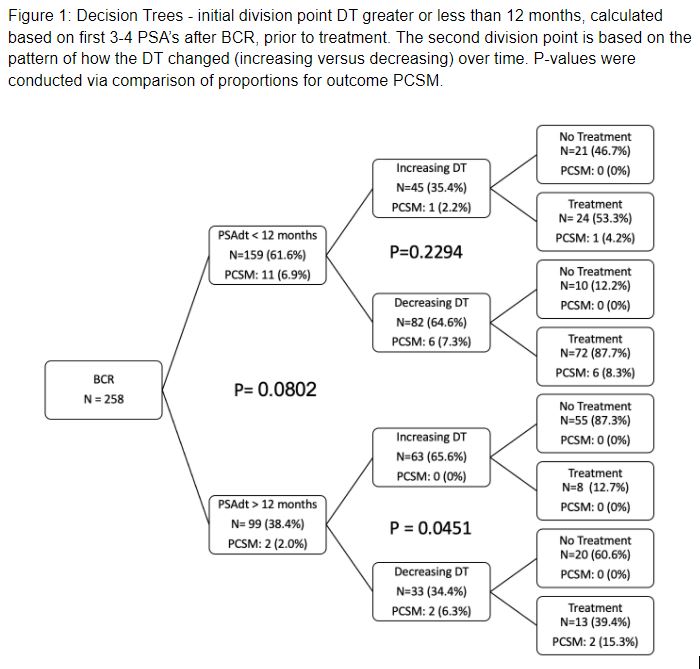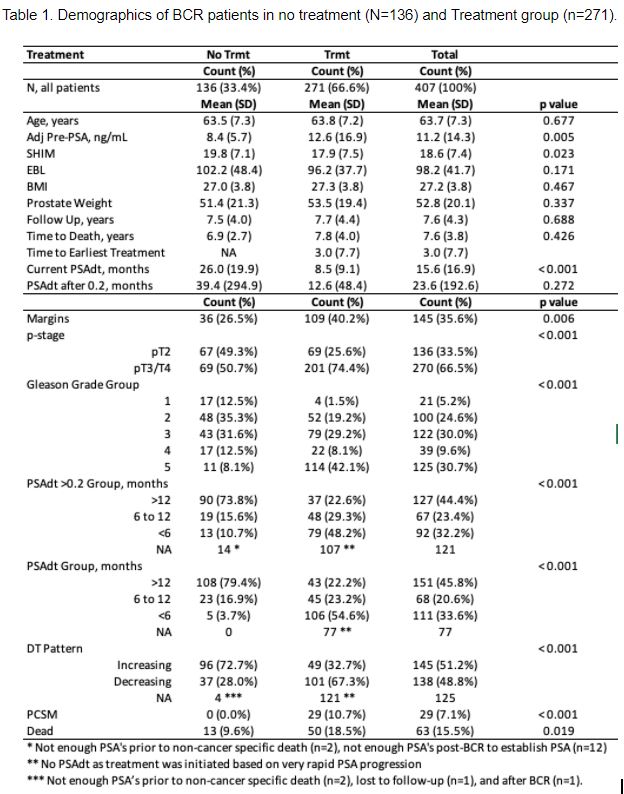Back
Poster, Podium & Video Sessions
Moderated Poster
MP57: Prostate Cancer: Localized: Surgical Therapy IV
MP57-19: Validation of Prostate Specific Antigen Doubling Time kinetics following Radical Prostatectomy to Guide Active Observation and Intervention
Monday, May 16, 2022
10:30 AM – 11:45 AM
Location: Room 225
Erica Huang*, Linda My Huynh, Adam Gordon, Ryan Chandhoke, Orange, CA, Blanca Morales, San Francisco, CA, Douglas Skarecky, Joshua Tran, Thomas Ahlering, Orange, CA

Erica Huang, BA, MSC
University of California, Irvine Medical Center
Poster Presenter(s)
Introduction: Biochemical recurrence (BCR) following radical prostatectomy (RP) has limited ability to predict metastatic progression or prostate cancer specific mortality (PCSM). In our experience, a significant number of men with BCR have non-lethal BCR that can be safely observed based on PSA doubling time (DT) and subsequent DT change without radiation (RT) and/or androgen deprivation therapy (ADT). The present study seeks to validate the use of DT kinetics to direct active observation (AO) and intervention.
Methods: A retrospective cohort analysis of 1864 men who underwent RP between June 2002 and September 2019 was conducted. Patients were assessed for treatment intervention (RT and/or ADT) versus AO with DT kinetics. Our main outcome was the predictive value of multivariate regression models for no treatment via ROC analysis. Secondary outcomes were PCSM via Kaplan-Meier analysis.
Results: 407/1864 (21.8%) men experienced BCR (PSA > 0.2 ng/dl, x2), with median follow-up of 7.6 years (IQR 3.3-11.9) (Table 1). In multivariable analysis, DT>12 months (OR: 8.93, 95%CI: 4.53,17.6) and increasing DT (OR: 5.49, 95%CI: 2.81,10.71) were significant predictors for continued observation without treatment (p < 0.001), while pGGG, p-stage, age, and preoperative PSA were not. This model was an excellent predictor for continued no treatment (AUC=0.83). No patients with DT>12 months, increasing DT experienced PCSM (Figure 1).
Conclusions: In our experience, one third of patients with BCR were observed without RT and/or ADT, with 0% PCSM at mean 7.6 years follow-up. DT>12 months and increasing DT were excellent predictors of no need for treatment. We introduce PSA kinetics as a means for guiding need and/or no need for treatment intervention.
Source of Funding: N/A


Methods: A retrospective cohort analysis of 1864 men who underwent RP between June 2002 and September 2019 was conducted. Patients were assessed for treatment intervention (RT and/or ADT) versus AO with DT kinetics. Our main outcome was the predictive value of multivariate regression models for no treatment via ROC analysis. Secondary outcomes were PCSM via Kaplan-Meier analysis.
Results: 407/1864 (21.8%) men experienced BCR (PSA > 0.2 ng/dl, x2), with median follow-up of 7.6 years (IQR 3.3-11.9) (Table 1). In multivariable analysis, DT>12 months (OR: 8.93, 95%CI: 4.53,17.6) and increasing DT (OR: 5.49, 95%CI: 2.81,10.71) were significant predictors for continued observation without treatment (p < 0.001), while pGGG, p-stage, age, and preoperative PSA were not. This model was an excellent predictor for continued no treatment (AUC=0.83). No patients with DT>12 months, increasing DT experienced PCSM (Figure 1).
Conclusions: In our experience, one third of patients with BCR were observed without RT and/or ADT, with 0% PCSM at mean 7.6 years follow-up. DT>12 months and increasing DT were excellent predictors of no need for treatment. We introduce PSA kinetics as a means for guiding need and/or no need for treatment intervention.
Source of Funding: N/A

.jpg)
.jpg)